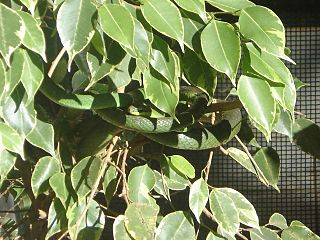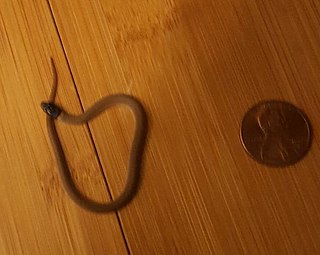Lutz's gecko, also known commonly as Bogert's gecko and Lutz' marked gecko, is a species of lizard in the family Phyllodactylidae. The species is endemic to Brazil.

Clelia is a genus of snakes, one of three genera with species with the common name mussurana or musurana. Clelia is a genus of large snakes in the family Colubridae. The genus is native to Central America and South America, and species of Clelia are found from southern Mexico to Brazil. They specialize in ophiophagy, i.e., they attack and eat other snakes. Currently seven species are recognized as being valid. They have other popular names in various countries, such as zopilota in Central America and cribo on some Caribbean islands.

Bogertophis is a genus of New World rat snakes in the family Colubridae. The genus is endemic to the southwestern United States and northern Mexico. There are two accepted species.

Chironius is a genus of New World colubrid snakes, commonly called sipos, savanes, or sometimes vine snakes. There are 23 described species in this genus.

Rhinocheilus is a genus of snakes, commonly called the long-nosed snakes, in the family Colubridae. The genus is native to the western United States and Mexico.

Tantilla hobartsmithi, commonly known as the southwestern blackhead snake, is a species of small colubrid snake native to the southwestern United States and northern Mexico.

Corallus cropanii, or Cropani's tree boa, is a species of boa, a snake in the family Boidae. The species is endemic to the state of São Paulo, Brazil. Like all boas, it is not venomous. No subspecies are currently recognized. Until 2017, no specimen of this snake had been seen alive since 1953 and only five dead specimens had been collected since then, but in late January 2017, an adult female Cropan's tree boa measuring 1.7 m was captured by locals in Ribeira who brought it to herpetologists from the Instituto Butantan and the Museum of Zoology of the University of São Paulo, who radio-tagged and released the animal to learn more about the species' behavior.
Liolaemus lutzae, called commonly Lutz's tree iguana, is a species of lizard in the family Liolaemidae. The species is endemic to Brazil.
The spatula-toothed snake is a species of snake in the family Colubridae. The species is endemic to Indonesia.

Bothrops lutzi, the Cerrado lancehead, is a species of venomous snake in the family Viperidae. The species is endemic to Central eastern Brazil. Within the country, it can be found in states such as: Minas Gerais, Bahia, Goiás, Tocantins, Piauí, and Ceará. The South American viper has sparked an interest from the scientific community due to its venom, as it is believed to have some therapeutic potential. Scientists have found that the venom carried by B. lutzi has antibacterial and antiparasitic effects, which can help fight against microbial resistance by medical patients, as well as parasitic diseases like leishmaniosis and Chagas’ disease.
Liotyphlops schubarti is a species of snake in the family Anomalepididae. The species is endemic to Brazil.
The Yonenga worm snake, also known commonly as Yonenaga's worm snake, is a species of snake in the family Typhlopidae. The species is endemic to Brazil.
Amastridium is a genus of snakes in the family Colubridae. The genus is endemic to Mexico, Central America and Colombia.

Phalotris is a genus of snakes of the subfamily Dipsadinae. All species of the genus Phalotris are found in South America. The specific name, mertensi, is in honor of German herpetologist Robert Mertens. The specific name, normanscotti, is in honor of Norman Scott, Jr., in recognition of his contribution to the knowledge of the herpetofauna of Paraguay.
Alexandresaurus is a genus of lizard in the family Gymnophthalmidae. The genus is monotypic, i.e., it contains only one species, Alexandresaurus camacan. The species is endemic to Brazil.

Phimophis guerini, also known commonly as the Argentine pampas snake, is a species of snake in the subfamily Dipsadinae of the family Colubridae. The species is endemic to South America.
Apostolepis gaboi, also known commonly as the sand dunes blackhead and the cobra-rainha das dunas in Brazilian Portuguese, is a species of snake in the family Colubridae. The species is endemic to Brazil.
Helicops gomesi, also known commonly as the São Paulo keelback and cobra d'água in Brazilian Portuguese, is a species of snake in the family Colubridae. The species is endemic to Brazil.
Rodriguesophis chui is a species of snake in the family Colubridae. It is found in Brazil.
Rodriguesophis iglesiasi, also known commonly as Gomes' pampas snake or Gomes's pampas snake, is a species of snake in the subfamily Dipsadinae of the family Colubridae. The species is endemic to Brazil.








